An Inquiry-Based Project: Zara Company Trends and Recommendations
VerifiedAdded on 2023/01/09
|17
|2813
|46
Project
AI Summary
This project provides a comprehensive analysis of the Zara company, focusing on its position within the retail industry. The project begins with an introduction outlining Zara's global presence and market impact, followed by a detailed examination of secondary research, highlighting key trends such as omnichannel retail, personalized experiences, the culture of immediacy, digital mobile payments, and expansion into new markets. Primary research, conducted through a questionnaire with Zara customers, analyzes shopping frequency, satisfaction with trend adaptation, personalized experiences, digital platform experiences, omnichannel strategy awareness, preferred shopping channels, technological integration, and technological innovations. The data analysis provides insights into customer perceptions and preferences. Based on the research, the project offers specific recommendations and an action plan for Zara, including updating operating systems, adopting new payment facilities, increasing digital promotions, enhancing personalization features, and improving omnichannel efficiency. The conclusion summarizes the findings and emphasizes the importance of adapting to current retail trends for sustained success.

AN INQUIRY-BASED
PROJECT OF ZARA
COMPANY
PROJECT OF ZARA
COMPANY
Paraphrase This Document
Need a fresh take? Get an instant paraphrase of this document with our AI Paraphraser
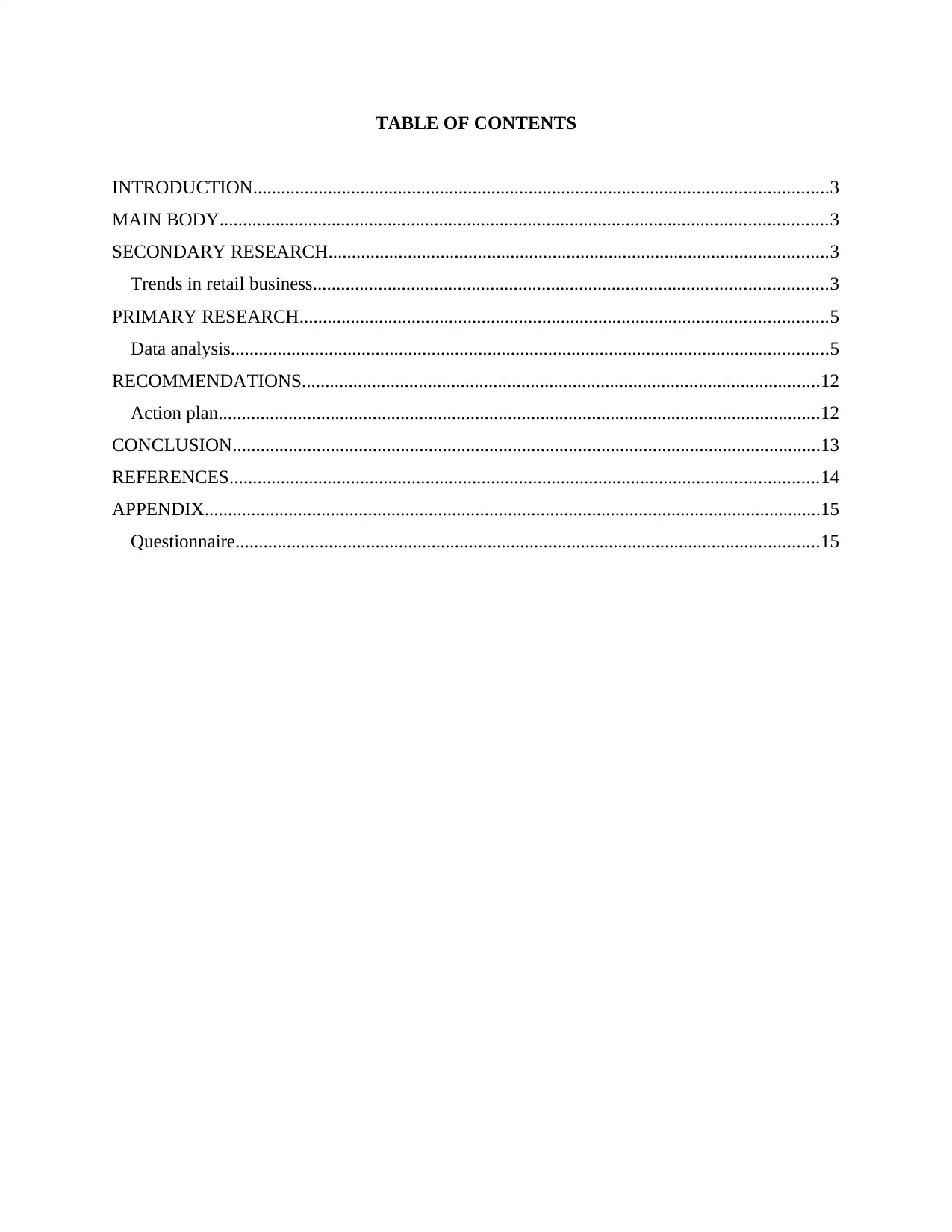
TABLE OF CONTENTS
INTRODUCTION...........................................................................................................................3
MAIN BODY..................................................................................................................................3
SECONDARY RESEARCH...........................................................................................................3
Trends in retail business..............................................................................................................3
PRIMARY RESEARCH.................................................................................................................5
Data analysis................................................................................................................................5
RECOMMENDATIONS...............................................................................................................12
Action plan.................................................................................................................................12
CONCLUSION..............................................................................................................................13
REFERENCES..............................................................................................................................14
APPENDIX....................................................................................................................................15
Questionnaire.............................................................................................................................15
INTRODUCTION...........................................................................................................................3
MAIN BODY..................................................................................................................................3
SECONDARY RESEARCH...........................................................................................................3
Trends in retail business..............................................................................................................3
PRIMARY RESEARCH.................................................................................................................5
Data analysis................................................................................................................................5
RECOMMENDATIONS...............................................................................................................12
Action plan.................................................................................................................................12
CONCLUSION..............................................................................................................................13
REFERENCES..............................................................................................................................14
APPENDIX....................................................................................................................................15
Questionnaire.............................................................................................................................15
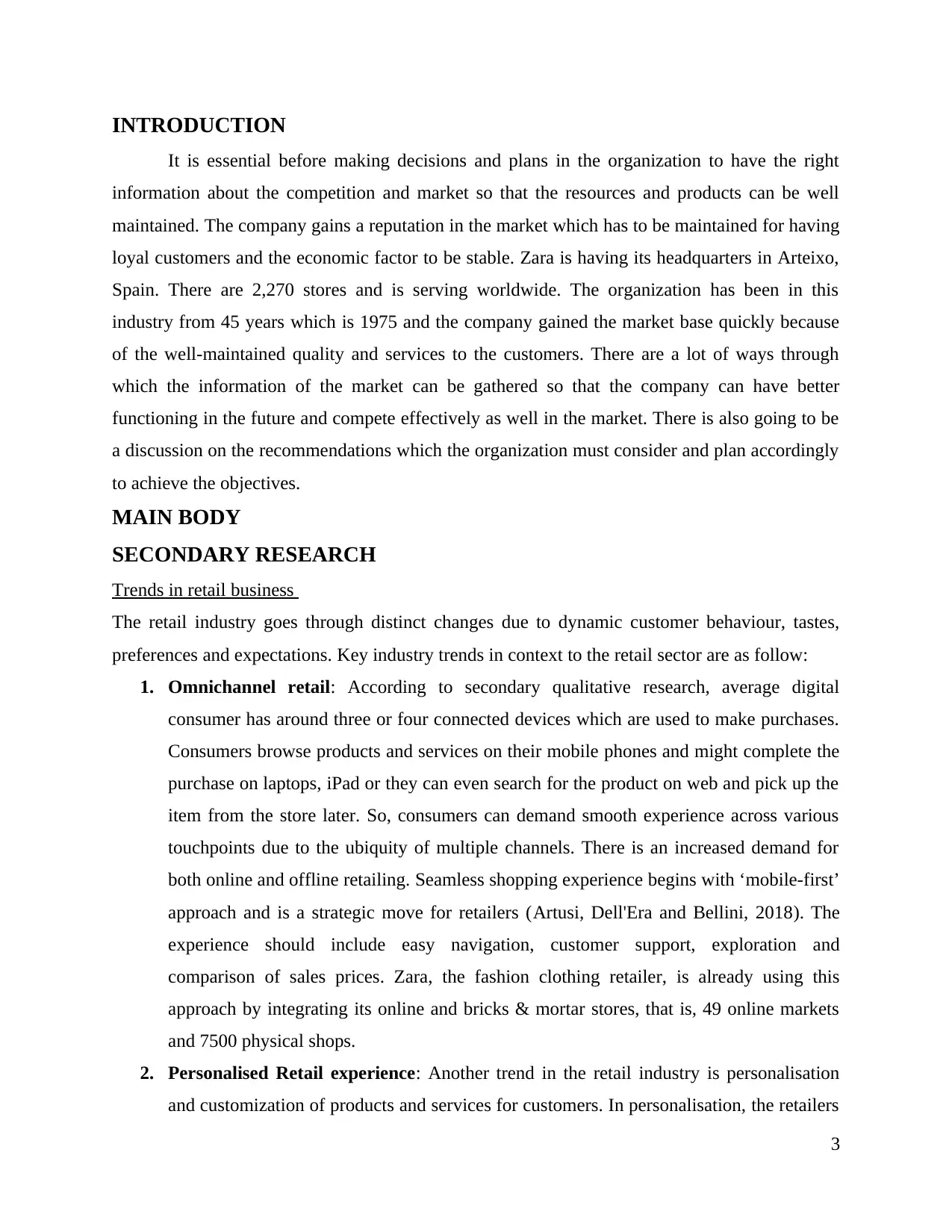
INTRODUCTION
It is essential before making decisions and plans in the organization to have the right
information about the competition and market so that the resources and products can be well
maintained. The company gains a reputation in the market which has to be maintained for having
loyal customers and the economic factor to be stable. Zara is having its headquarters in Arteixo,
Spain. There are 2,270 stores and is serving worldwide. The organization has been in this
industry from 45 years which is 1975 and the company gained the market base quickly because
of the well-maintained quality and services to the customers. There are a lot of ways through
which the information of the market can be gathered so that the company can have better
functioning in the future and compete effectively as well in the market. There is also going to be
a discussion on the recommendations which the organization must consider and plan accordingly
to achieve the objectives.
MAIN BODY
SECONDARY RESEARCH
Trends in retail business
The retail industry goes through distinct changes due to dynamic customer behaviour, tastes,
preferences and expectations. Key industry trends in context to the retail sector are as follow:
1. Omnichannel retail: According to secondary qualitative research, average digital
consumer has around three or four connected devices which are used to make purchases.
Consumers browse products and services on their mobile phones and might complete the
purchase on laptops, iPad or they can even search for the product on web and pick up the
item from the store later. So, consumers can demand smooth experience across various
touchpoints due to the ubiquity of multiple channels. There is an increased demand for
both online and offline retailing. Seamless shopping experience begins with ‘mobile-first’
approach and is a strategic move for retailers (Artusi, Dell'Era and Bellini, 2018). The
experience should include easy navigation, customer support, exploration and
comparison of sales prices. Zara, the fashion clothing retailer, is already using this
approach by integrating its online and bricks & mortar stores, that is, 49 online markets
and 7500 physical shops.
2. Personalised Retail experience: Another trend in the retail industry is personalisation
and customization of products and services for customers. In personalisation, the retailers
3
It is essential before making decisions and plans in the organization to have the right
information about the competition and market so that the resources and products can be well
maintained. The company gains a reputation in the market which has to be maintained for having
loyal customers and the economic factor to be stable. Zara is having its headquarters in Arteixo,
Spain. There are 2,270 stores and is serving worldwide. The organization has been in this
industry from 45 years which is 1975 and the company gained the market base quickly because
of the well-maintained quality and services to the customers. There are a lot of ways through
which the information of the market can be gathered so that the company can have better
functioning in the future and compete effectively as well in the market. There is also going to be
a discussion on the recommendations which the organization must consider and plan accordingly
to achieve the objectives.
MAIN BODY
SECONDARY RESEARCH
Trends in retail business
The retail industry goes through distinct changes due to dynamic customer behaviour, tastes,
preferences and expectations. Key industry trends in context to the retail sector are as follow:
1. Omnichannel retail: According to secondary qualitative research, average digital
consumer has around three or four connected devices which are used to make purchases.
Consumers browse products and services on their mobile phones and might complete the
purchase on laptops, iPad or they can even search for the product on web and pick up the
item from the store later. So, consumers can demand smooth experience across various
touchpoints due to the ubiquity of multiple channels. There is an increased demand for
both online and offline retailing. Seamless shopping experience begins with ‘mobile-first’
approach and is a strategic move for retailers (Artusi, Dell'Era and Bellini, 2018). The
experience should include easy navigation, customer support, exploration and
comparison of sales prices. Zara, the fashion clothing retailer, is already using this
approach by integrating its online and bricks & mortar stores, that is, 49 online markets
and 7500 physical shops.
2. Personalised Retail experience: Another trend in the retail industry is personalisation
and customization of products and services for customers. In personalisation, the retailers
3
⊘ This is a preview!⊘
Do you want full access?
Subscribe today to unlock all pages.

Trusted by 1+ million students worldwide

give suggestions and to customers on the basis of their preferences, order history,
location and previous searches. It is also done through interaction and customer
engagement via text messages, tele based communications, order updates etc. Artificial
intelligence is also used to predict and suggest customers to emphasize on a more unique
customer approach. Zara’s ‘Edited’ customization features allows customers to
personalise apparels like denims, sweaters et. According to the choice of embroidery or
shades, fonts for letter prints etc. This is enabled through a tech pop-up interactive A R
experience.
3. Culture of immediacy: The significant rise in technology has led to a growth in
impatient customers. According to secondary qualitative research of KANA software, the
present generations wants a communication response in under 10 minutes as opposed to
the previous generation who could wait for the response for a period of 10 days
(Sugimoto and Nagasawa, 2017). Therefore, the retailers are ensuring a fast-paced
process and culture in their organisations by enhancing their supply-chain. They carry
activities like displaying and updating inventory in real-time, providing same day
delivery options, quick restocking etc. Zara offers of-the-moment fashion and has
vertically integrated the company to design, produce and distribute apparels and garments
to their retail stores as quickly as three weeks.
4. Digital mobile payments: When it comes to payment methods, the retail industry
heavily relies upon mobile payment services and mobile wallets apart from cash, debit
and credit cards. According to a study by Bank of America, 91% people out of 1000
viewed mobile phones as ‘indispensable companion’ (Horn, Oehler and Wendt, 2020).
Most retailers are adopting API systems for seamless payment experience and merchants
are increasingly using services like Apple pay, Mastercard PayPass, PayPal, Android pay
and currently trending Google Pay. Therefore, incorporation of digital wallets is a
necessity in current times to cope up with future billing and payment techniques. Zara
uses NFC contactless tech and QR code scanning to enable transactions and has started
using Inditex brand’s (parent company) umbrella payment app called InWallet.
5. New Markets: Retail industry if aimed at finding new channels by using technology to
tap into new and emerging markets. Overseas and digital expansion is what retailers are
trying to attain to maximise their reach across the globe. Adoption of a ‘digital first’
4
location and previous searches. It is also done through interaction and customer
engagement via text messages, tele based communications, order updates etc. Artificial
intelligence is also used to predict and suggest customers to emphasize on a more unique
customer approach. Zara’s ‘Edited’ customization features allows customers to
personalise apparels like denims, sweaters et. According to the choice of embroidery or
shades, fonts for letter prints etc. This is enabled through a tech pop-up interactive A R
experience.
3. Culture of immediacy: The significant rise in technology has led to a growth in
impatient customers. According to secondary qualitative research of KANA software, the
present generations wants a communication response in under 10 minutes as opposed to
the previous generation who could wait for the response for a period of 10 days
(Sugimoto and Nagasawa, 2017). Therefore, the retailers are ensuring a fast-paced
process and culture in their organisations by enhancing their supply-chain. They carry
activities like displaying and updating inventory in real-time, providing same day
delivery options, quick restocking etc. Zara offers of-the-moment fashion and has
vertically integrated the company to design, produce and distribute apparels and garments
to their retail stores as quickly as three weeks.
4. Digital mobile payments: When it comes to payment methods, the retail industry
heavily relies upon mobile payment services and mobile wallets apart from cash, debit
and credit cards. According to a study by Bank of America, 91% people out of 1000
viewed mobile phones as ‘indispensable companion’ (Horn, Oehler and Wendt, 2020).
Most retailers are adopting API systems for seamless payment experience and merchants
are increasingly using services like Apple pay, Mastercard PayPass, PayPal, Android pay
and currently trending Google Pay. Therefore, incorporation of digital wallets is a
necessity in current times to cope up with future billing and payment techniques. Zara
uses NFC contactless tech and QR code scanning to enable transactions and has started
using Inditex brand’s (parent company) umbrella payment app called InWallet.
5. New Markets: Retail industry if aimed at finding new channels by using technology to
tap into new and emerging markets. Overseas and digital expansion is what retailers are
trying to attain to maximise their reach across the globe. Adoption of a ‘digital first’
4
Paraphrase This Document
Need a fresh take? Get an instant paraphrase of this document with our AI Paraphraser
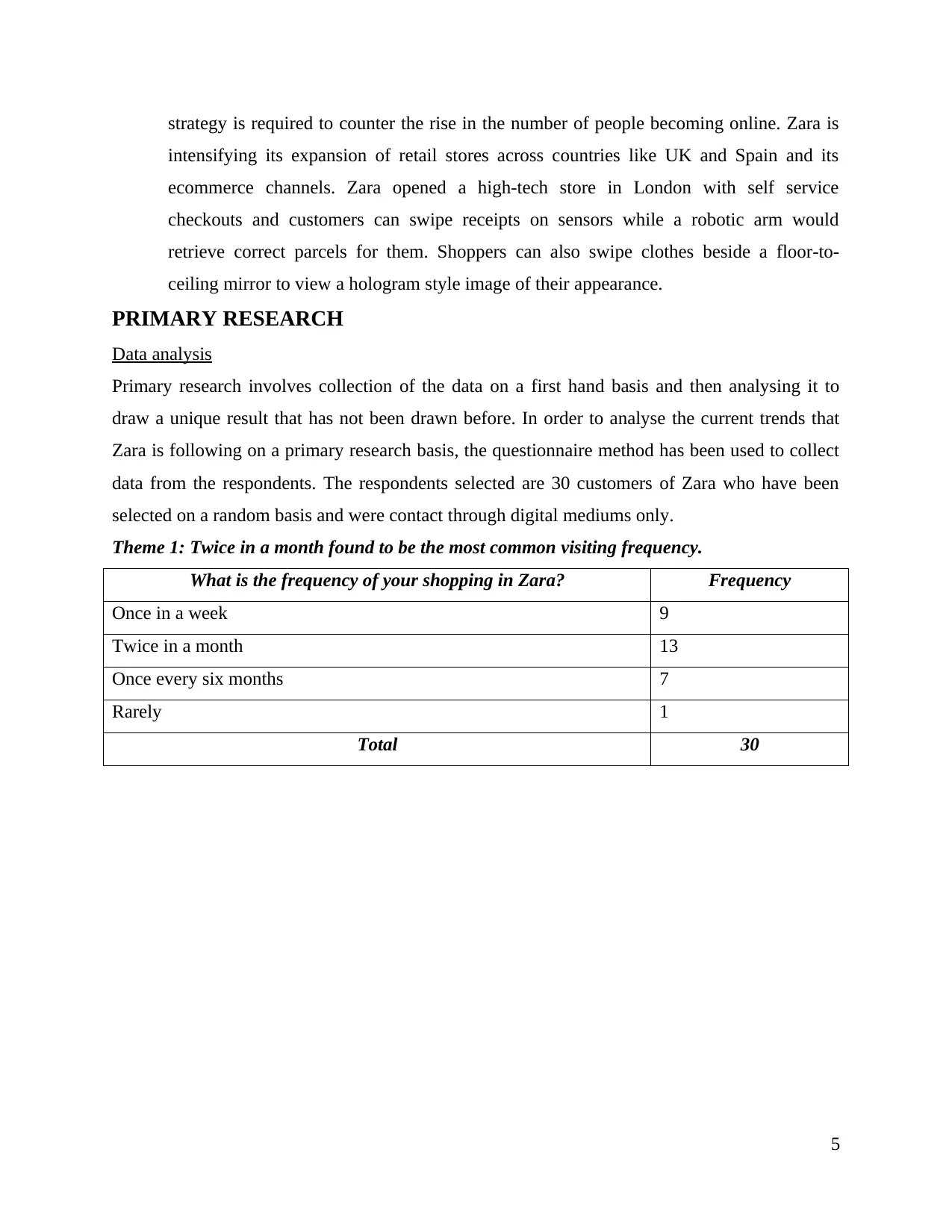
strategy is required to counter the rise in the number of people becoming online. Zara is
intensifying its expansion of retail stores across countries like UK and Spain and its
ecommerce channels. Zara opened a high-tech store in London with self service
checkouts and customers can swipe receipts on sensors while a robotic arm would
retrieve correct parcels for them. Shoppers can also swipe clothes beside a floor-to-
ceiling mirror to view a hologram style image of their appearance.
PRIMARY RESEARCH
Data analysis
Primary research involves collection of the data on a first hand basis and then analysing it to
draw a unique result that has not been drawn before. In order to analyse the current trends that
Zara is following on a primary research basis, the questionnaire method has been used to collect
data from the respondents. The respondents selected are 30 customers of Zara who have been
selected on a random basis and were contact through digital mediums only.
Theme 1: Twice in a month found to be the most common visiting frequency.
What is the frequency of your shopping in Zara? Frequency
Once in a week 9
Twice in a month 13
Once every six months 7
Rarely 1
Total 30
5
intensifying its expansion of retail stores across countries like UK and Spain and its
ecommerce channels. Zara opened a high-tech store in London with self service
checkouts and customers can swipe receipts on sensors while a robotic arm would
retrieve correct parcels for them. Shoppers can also swipe clothes beside a floor-to-
ceiling mirror to view a hologram style image of their appearance.
PRIMARY RESEARCH
Data analysis
Primary research involves collection of the data on a first hand basis and then analysing it to
draw a unique result that has not been drawn before. In order to analyse the current trends that
Zara is following on a primary research basis, the questionnaire method has been used to collect
data from the respondents. The respondents selected are 30 customers of Zara who have been
selected on a random basis and were contact through digital mediums only.
Theme 1: Twice in a month found to be the most common visiting frequency.
What is the frequency of your shopping in Zara? Frequency
Once in a week 9
Twice in a month 13
Once every six months 7
Rarely 1
Total 30
5
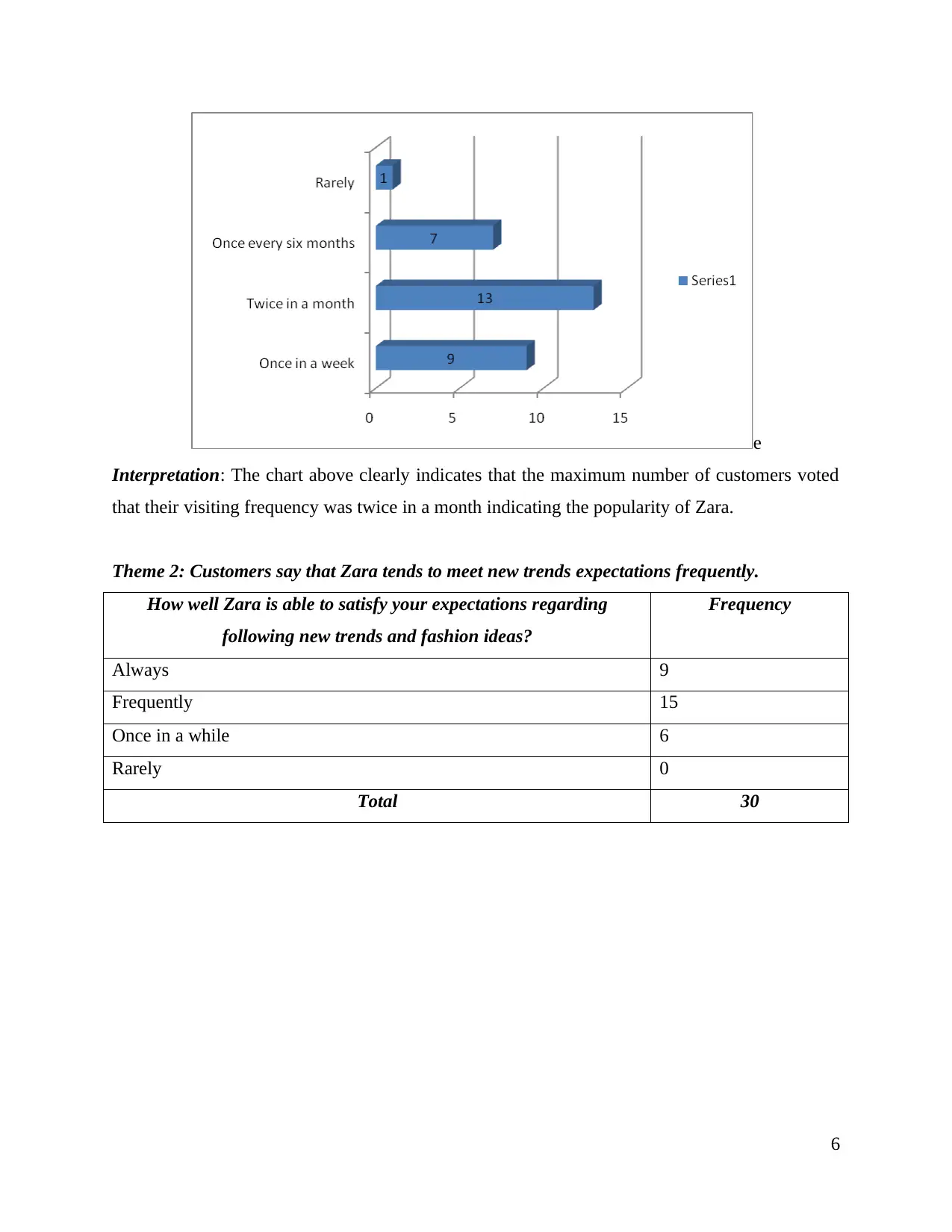
e
Interpretation: The chart above clearly indicates that the maximum number of customers voted
that their visiting frequency was twice in a month indicating the popularity of Zara.
Theme 2: Customers say that Zara tends to meet new trends expectations frequently.
How well Zara is able to satisfy your expectations regarding
following new trends and fashion ideas?
Frequency
Always 9
Frequently 15
Once in a while 6
Rarely 0
Total 30
6
Interpretation: The chart above clearly indicates that the maximum number of customers voted
that their visiting frequency was twice in a month indicating the popularity of Zara.
Theme 2: Customers say that Zara tends to meet new trends expectations frequently.
How well Zara is able to satisfy your expectations regarding
following new trends and fashion ideas?
Frequency
Always 9
Frequently 15
Once in a while 6
Rarely 0
Total 30
6
⊘ This is a preview!⊘
Do you want full access?
Subscribe today to unlock all pages.

Trusted by 1+ million students worldwide
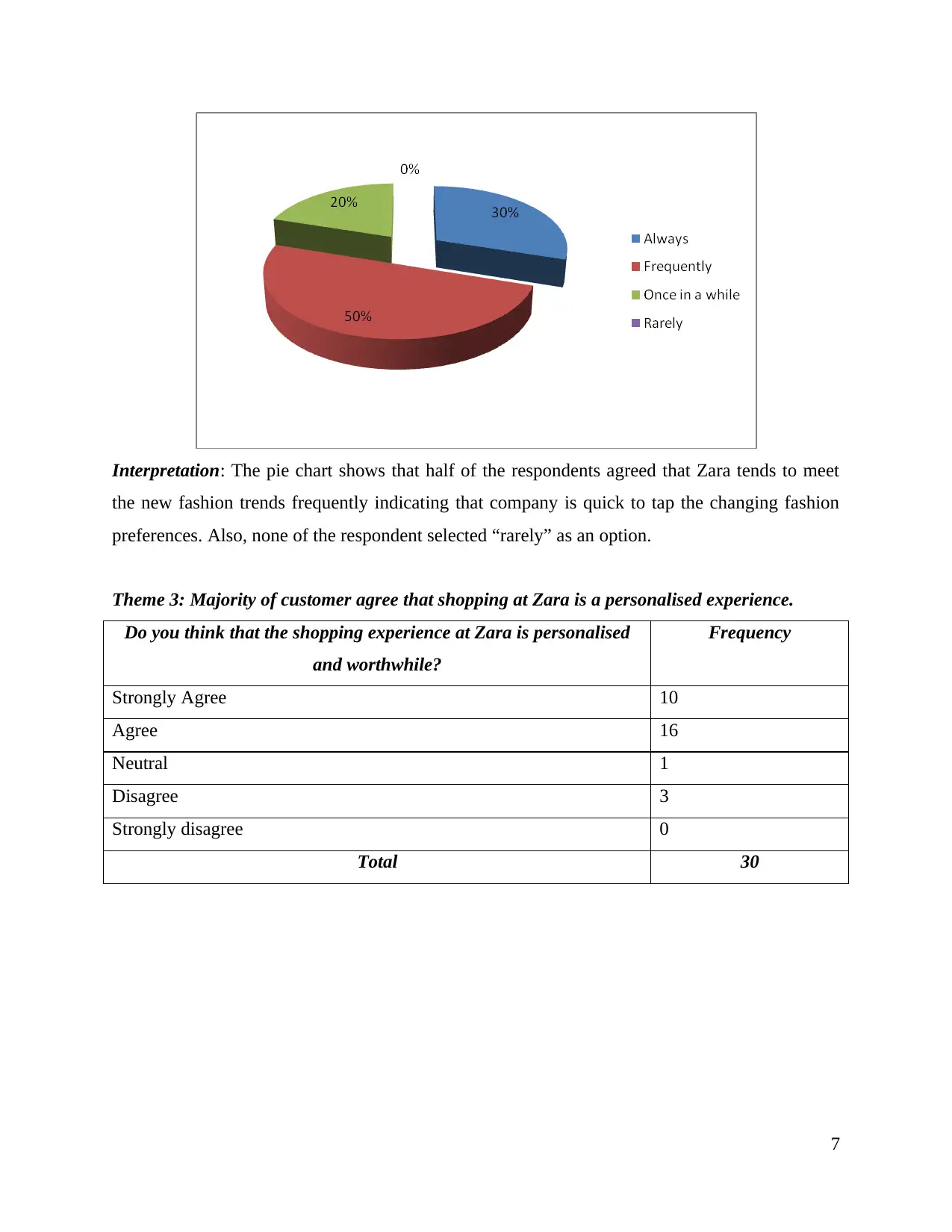
Interpretation: The pie chart shows that half of the respondents agreed that Zara tends to meet
the new fashion trends frequently indicating that company is quick to tap the changing fashion
preferences. Also, none of the respondent selected “rarely” as an option.
Theme 3: Majority of customer agree that shopping at Zara is a personalised experience.
Do you think that the shopping experience at Zara is personalised
and worthwhile?
Frequency
Strongly Agree 10
Agree 16
Neutral 1
Disagree 3
Strongly disagree 0
Total 30
7
the new fashion trends frequently indicating that company is quick to tap the changing fashion
preferences. Also, none of the respondent selected “rarely” as an option.
Theme 3: Majority of customer agree that shopping at Zara is a personalised experience.
Do you think that the shopping experience at Zara is personalised
and worthwhile?
Frequency
Strongly Agree 10
Agree 16
Neutral 1
Disagree 3
Strongly disagree 0
Total 30
7
Paraphrase This Document
Need a fresh take? Get an instant paraphrase of this document with our AI Paraphraser
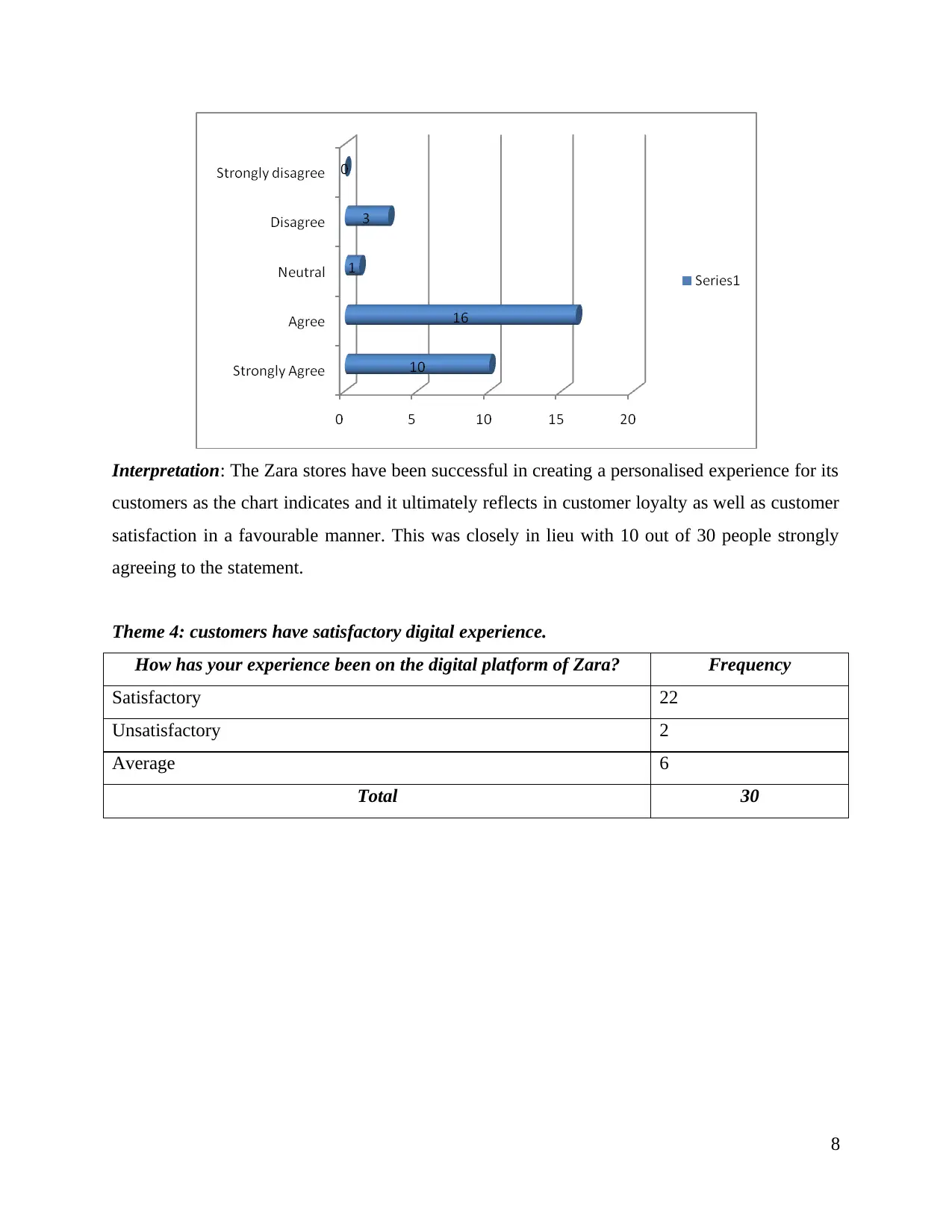
Interpretation: The Zara stores have been successful in creating a personalised experience for its
customers as the chart indicates and it ultimately reflects in customer loyalty as well as customer
satisfaction in a favourable manner. This was closely in lieu with 10 out of 30 people strongly
agreeing to the statement.
Theme 4: customers have satisfactory digital experience.
How has your experience been on the digital platform of Zara? Frequency
Satisfactory 22
Unsatisfactory 2
Average 6
Total 30
8
customers as the chart indicates and it ultimately reflects in customer loyalty as well as customer
satisfaction in a favourable manner. This was closely in lieu with 10 out of 30 people strongly
agreeing to the statement.
Theme 4: customers have satisfactory digital experience.
How has your experience been on the digital platform of Zara? Frequency
Satisfactory 22
Unsatisfactory 2
Average 6
Total 30
8
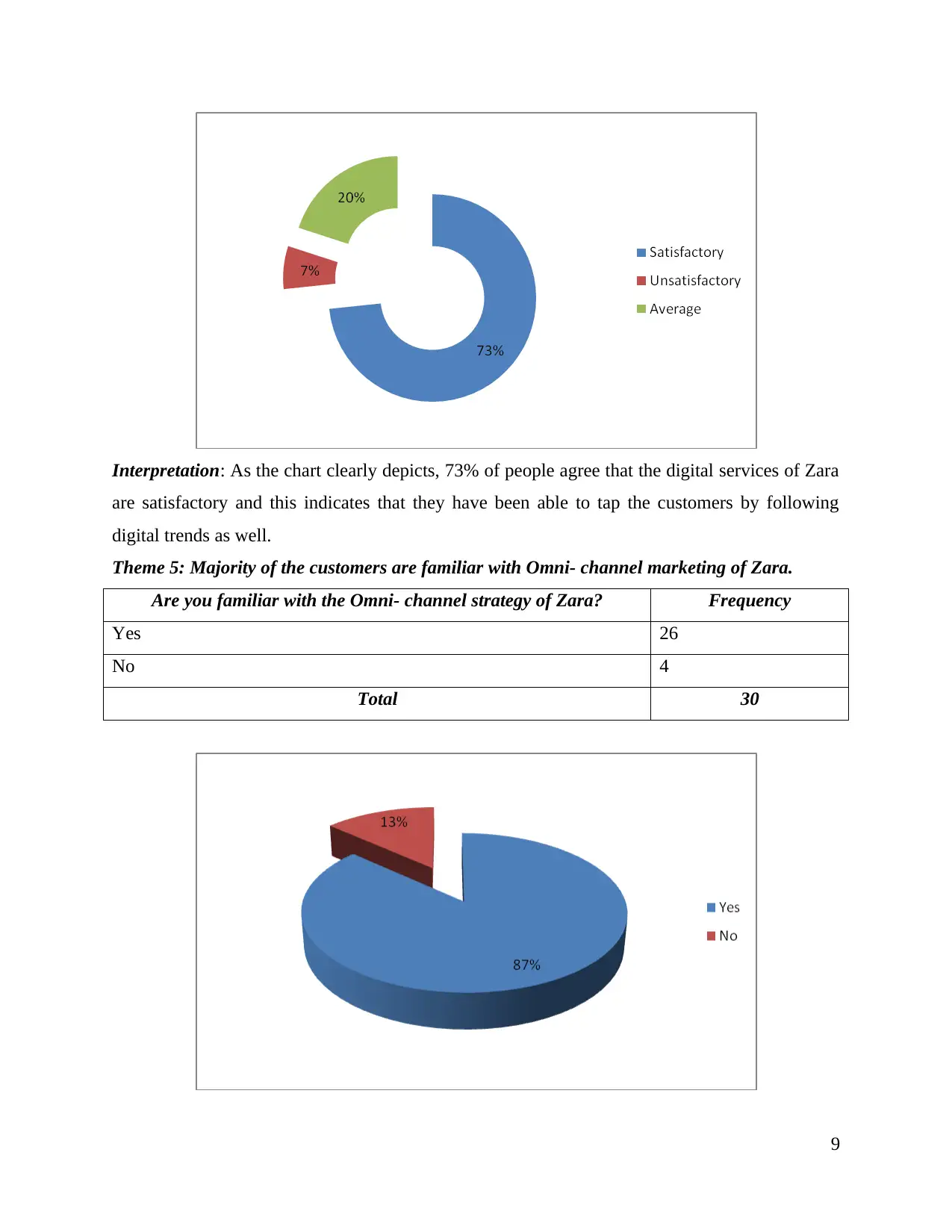
Interpretation: As the chart clearly depicts, 73% of people agree that the digital services of Zara
are satisfactory and this indicates that they have been able to tap the customers by following
digital trends as well.
Theme 5: Majority of the customers are familiar with Omni- channel marketing of Zara.
Are you familiar with the Omni- channel strategy of Zara? Frequency
Yes 26
No 4
Total 30
9
are satisfactory and this indicates that they have been able to tap the customers by following
digital trends as well.
Theme 5: Majority of the customers are familiar with Omni- channel marketing of Zara.
Are you familiar with the Omni- channel strategy of Zara? Frequency
Yes 26
No 4
Total 30
9
⊘ This is a preview!⊘
Do you want full access?
Subscribe today to unlock all pages.

Trusted by 1+ million students worldwide
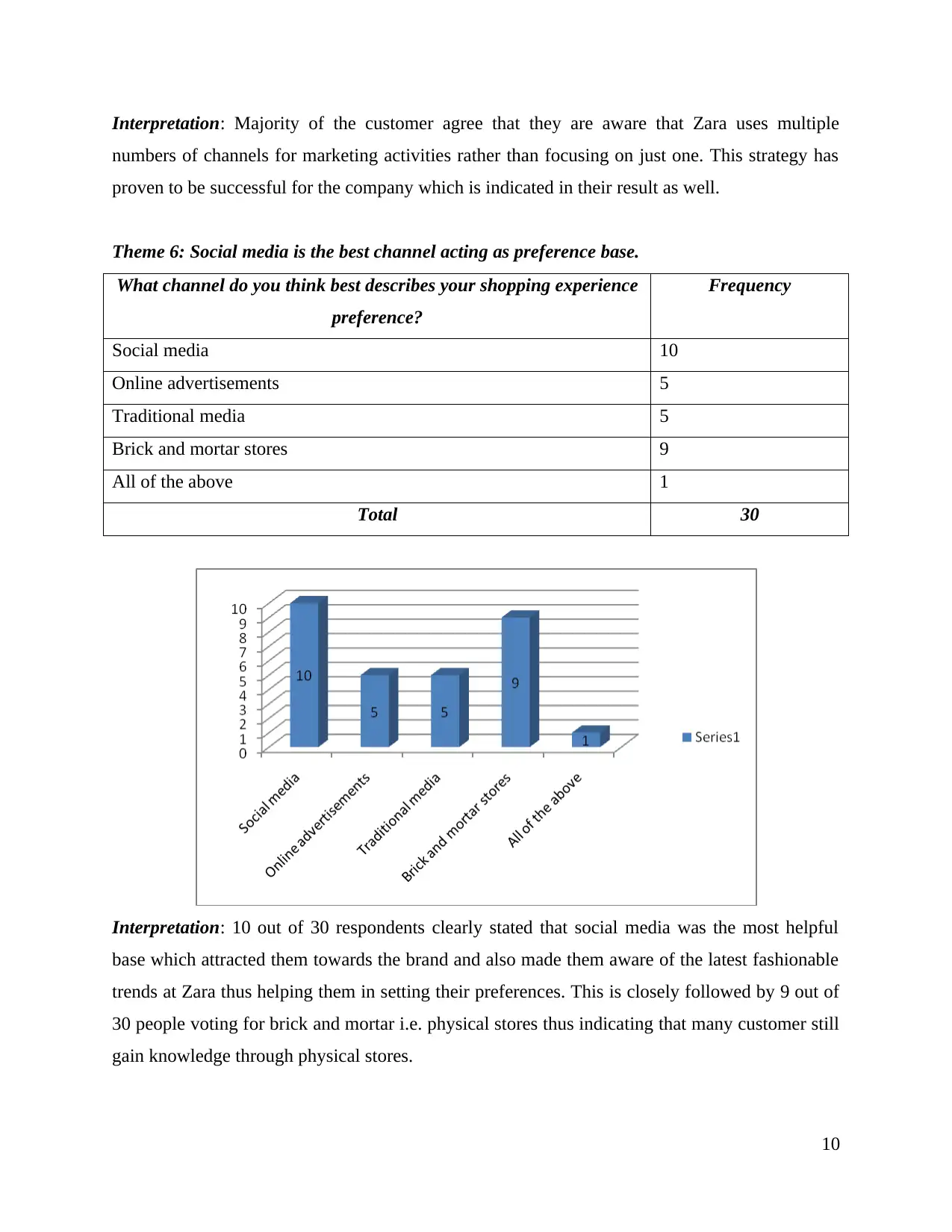
Interpretation: Majority of the customer agree that they are aware that Zara uses multiple
numbers of channels for marketing activities rather than focusing on just one. This strategy has
proven to be successful for the company which is indicated in their result as well.
Theme 6: Social media is the best channel acting as preference base.
What channel do you think best describes your shopping experience
preference?
Frequency
Social media 10
Online advertisements 5
Traditional media 5
Brick and mortar stores 9
All of the above 1
Total 30
Interpretation: 10 out of 30 respondents clearly stated that social media was the most helpful
base which attracted them towards the brand and also made them aware of the latest fashionable
trends at Zara thus helping them in setting their preferences. This is closely followed by 9 out of
30 people voting for brick and mortar i.e. physical stores thus indicating that many customer still
gain knowledge through physical stores.
10
numbers of channels for marketing activities rather than focusing on just one. This strategy has
proven to be successful for the company which is indicated in their result as well.
Theme 6: Social media is the best channel acting as preference base.
What channel do you think best describes your shopping experience
preference?
Frequency
Social media 10
Online advertisements 5
Traditional media 5
Brick and mortar stores 9
All of the above 1
Total 30
Interpretation: 10 out of 30 respondents clearly stated that social media was the most helpful
base which attracted them towards the brand and also made them aware of the latest fashionable
trends at Zara thus helping them in setting their preferences. This is closely followed by 9 out of
30 people voting for brick and mortar i.e. physical stores thus indicating that many customer still
gain knowledge through physical stores.
10
Paraphrase This Document
Need a fresh take? Get an instant paraphrase of this document with our AI Paraphraser
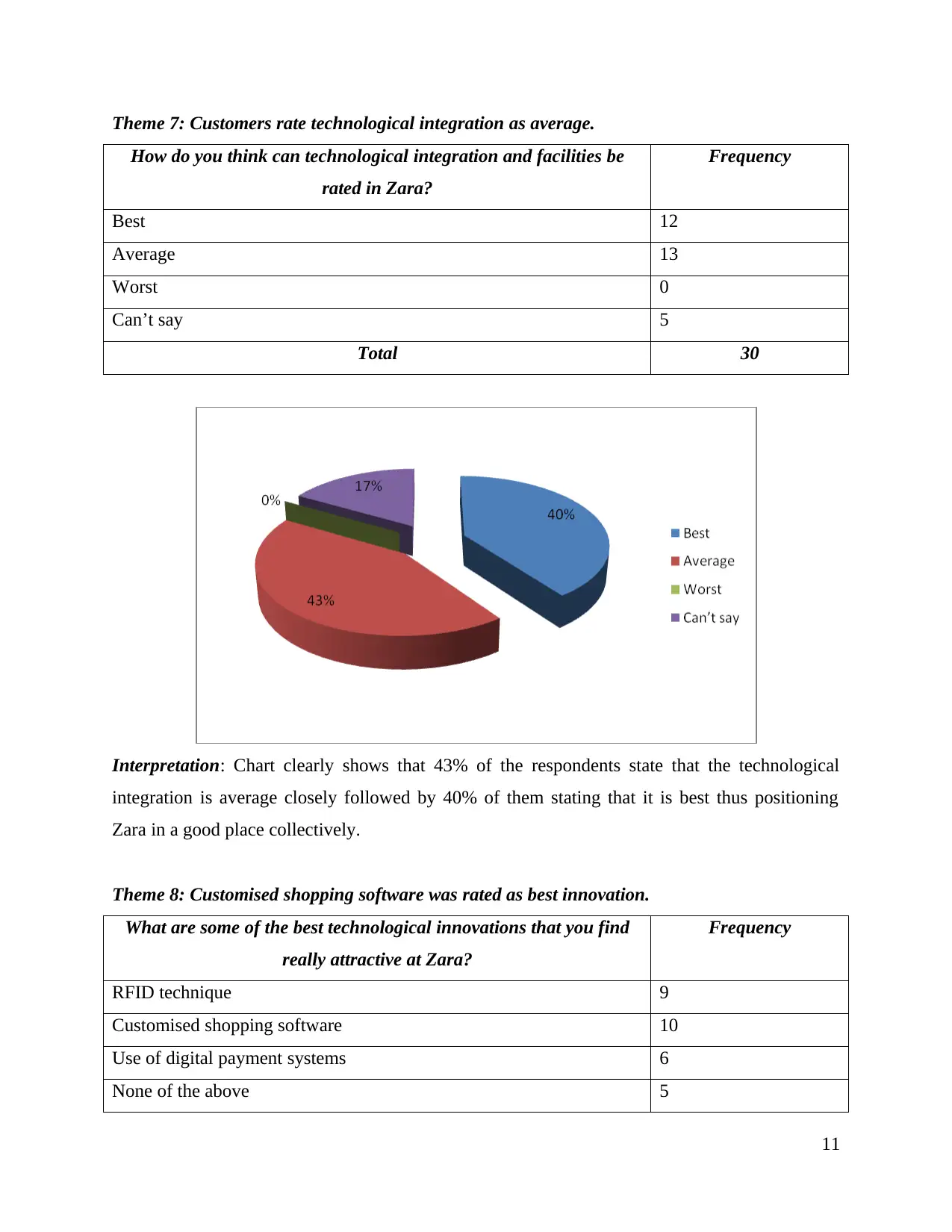
Theme 7: Customers rate technological integration as average.
How do you think can technological integration and facilities be
rated in Zara?
Frequency
Best 12
Average 13
Worst 0
Can’t say 5
Total 30
Interpretation: Chart clearly shows that 43% of the respondents state that the technological
integration is average closely followed by 40% of them stating that it is best thus positioning
Zara in a good place collectively.
Theme 8: Customised shopping software was rated as best innovation.
What are some of the best technological innovations that you find
really attractive at Zara?
Frequency
RFID technique 9
Customised shopping software 10
Use of digital payment systems 6
None of the above 5
11
How do you think can technological integration and facilities be
rated in Zara?
Frequency
Best 12
Average 13
Worst 0
Can’t say 5
Total 30
Interpretation: Chart clearly shows that 43% of the respondents state that the technological
integration is average closely followed by 40% of them stating that it is best thus positioning
Zara in a good place collectively.
Theme 8: Customised shopping software was rated as best innovation.
What are some of the best technological innovations that you find
really attractive at Zara?
Frequency
RFID technique 9
Customised shopping software 10
Use of digital payment systems 6
None of the above 5
11

Total 30
Interpretation: As the chart states, 33% of the customised shopping assistant of Zara available
for assistance in online purchasing websites is the best technological update and is closely
followed by RFID technique with 30%.
RECOMMENDATIONS
Action plan
Recommendations in context to set objectives for Zara in order to adapt to the current trends of
the retail industry and increase its operational efficiency are as follows:
Objective: To update operating system across Zara stores
Currently the clothing company is using DOS-based POS system for its daily operations.
Although the current system is quite efficient, it is strategic and more appropriate for the
company to upgrade to a modern operating system such as Linux or windows throughout
the stores of the company which come with many benefits like new capabilities and
network extension (Biswas and Irwin Casterella, 2019). However, it is a huge
undertaking for the parent company Inditex to incorporate the POS system across 950
stores.
Objective: To adopt new payment facilities in order to smoothen billing process
Zara should also adopt digital wallet payment methods apart from Inditex’s own payment
system- InWallet. The customers are increasingly relying upon digital wallets like
12
Interpretation: As the chart states, 33% of the customised shopping assistant of Zara available
for assistance in online purchasing websites is the best technological update and is closely
followed by RFID technique with 30%.
RECOMMENDATIONS
Action plan
Recommendations in context to set objectives for Zara in order to adapt to the current trends of
the retail industry and increase its operational efficiency are as follows:
Objective: To update operating system across Zara stores
Currently the clothing company is using DOS-based POS system for its daily operations.
Although the current system is quite efficient, it is strategic and more appropriate for the
company to upgrade to a modern operating system such as Linux or windows throughout
the stores of the company which come with many benefits like new capabilities and
network extension (Biswas and Irwin Casterella, 2019). However, it is a huge
undertaking for the parent company Inditex to incorporate the POS system across 950
stores.
Objective: To adopt new payment facilities in order to smoothen billing process
Zara should also adopt digital wallet payment methods apart from Inditex’s own payment
system- InWallet. The customers are increasingly relying upon digital wallets like
12
⊘ This is a preview!⊘
Do you want full access?
Subscribe today to unlock all pages.

Trusted by 1+ million students worldwide
1 out of 17
Related Documents
Your All-in-One AI-Powered Toolkit for Academic Success.
+13062052269
info@desklib.com
Available 24*7 on WhatsApp / Email
![[object Object]](/_next/static/media/star-bottom.7253800d.svg)
Unlock your academic potential
Copyright © 2020–2025 A2Z Services. All Rights Reserved. Developed and managed by ZUCOL.




